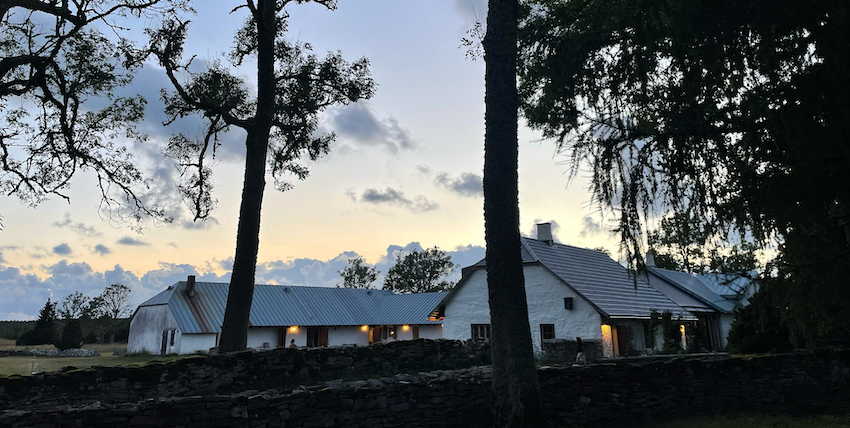Travel
Estonia Travel Guide: Clean, Green and Serene

When I say that the residents of Tallinn, the capital of Estonia, rarely seem to be without their laptops, it might sound like a depressing observation. But when I say that they’re often seated under a pine tree, or in an airy café in a post-industrial creative hub, or – I don’t know – beneath the shady walls of a medieval fortress, the whole thing starts to seem a lot more wholesome. But while Estonians seem to have mastered the work-life balance, “work” is unlikely to be high on your to-do list when you’re on holiday there. And if you haven’t considered it before – which, given it’s the kind of place that likes to hide its light under a bushel, you probably haven’t – here’s why you should.
Having recently spent a week exploring the west coast, I was amazed that no one had alerted me to its charms sooner; though with the Mediterranean increasingly inhospitable in the summer months (to put it mildly), it seems likely that more people will twig. Estonia is easily accessible by direct flights from London, although my family and I arrived – more memorably – from Stockholm, Sweden, to the capital city, Tallinn, on an overnight mega-ferry which had a casino, a disco and a last-days-of-Rome buffet at which I saw – no lie – a woman carrying a plate of prawns and chocolate mousse.
Tallinn boasts a picturesque Old Town of cobbled streets and colourful houses and a number of buzzy, creative neighbourhoods, including Telliskivi, home to an impressive branch of the Swedish photography gallery Fotografiska, and Noblessner, which has the Proto invention factory and the Kai Art Centre. It’s an atmospheric place to walk around, take in some churches, squares and battlements (and some anti-Putin sentiments, which were liberally displayed outside the Russian Embassy).
But it’s beyond the capital that Estonia really works its quiet magic. Estonia has a reputation as technologically advanced country – it has been named “the most advanced digital society in the world” – but perhaps less known is the fact that 50 per cent of it is covered in forest, or that it has more than 2000 islands in the Baltic Sea (fun fact: its coastal neighbour, Latvia, has zero).
After a day exploring Tallinn, we headed west to LaSpa Laulasmaa, a tasteful resort hotel that sits in among pine trees (yes, you will detect an arboreal theme) to stay in the recently renovated Beach House block. If you choose to leave the hotel – though why would you! As well as a Michelin-starred restaurant it’s got ping pong, giant chess, and an incomprehensible Finnish throwing game called Mölkky! – a sandy cycle ride away is the Aarvo Pärt Centre, an extraordinary modernist building surrounded by pine trees and dedicated to Estonia’s famous composer.
A short walk from the hotel, and an even shorter walk from the Beach House, were modest dunes and, beyond those, a serene, sandy beach. It was all readily swimmable, bar a lot of tiny jellyfish, although they appeared to be largely ornamental. Still, to change things up, the hotel also has a fun pool with all kinds of saunas and steam rooms of different temperatures and aromas that make British municipal swimming pool rules look unbelievably uptight (want to bring your baby in for a salt scrub? No problem!).
Bathing, as becomes apparent after not very long at all in the country, is very important to Estonians. Our next stop, the coastal town of Haapsalu, made its name as a mud cure resort in the 19th century, quickly gaining a reputation among prosperous Russians, and even the doomed Romanovs. Today, the Hestia Hotel Haapsalu Spa, on the shores of the Vaika Viik and close to the scenic old town, has yet another understatedly great spa complex, with a pool that provides views of the sun setting over the lake.
Given that Estonia reclaimed its independence from the Soviet Union in 1991, there are parts of the country that have been mysterious even to its own nationals until fairly recently. Saaremaa, for example, Estonia’s largest island, and our next stop, was closed off in 1946; today one is as likely to come across concrete Soviet-era buildings among the pine trees (them again) as traditional wooden Estonian country houses.
As a result, tourism is in a comparatively nascent phase, which means that many of its more beautiful areas are yet to be overrun. Even Pädaste Manor, one of the more luxurious Estonian offerings, where we spent our final night, has a decidedly mellow vibe. (This might also be due to the fact that Estonians are, by nature, somewhat recessive types who are unlikely to toot their own trumpets; ask anyone if they speak English and they’ll mutter shyly that they can speak a bit, only to reveal themselves completely fluent.)
An even more pronounced example is Pilguse Residency on the south-west corner of Saaremaa [pictured top] – which we accessed by ferry from the neighbouring island of Hiumaa, home to the understatedly excellent Windtower Museum. A 16th-century manor set over 90 hectares of low-lying fields, populated by wild ponies, Pilguse (pronounced pill-goo-say) offers accommodation of varying levels, from glamping to hotel rooms to a stand-along cottage to crazy-looking mirror cabins. In the Mediterranean, somewhere like this would overbooked and unaffordable, but that, as you may well be grasping by now, is not the Estonian way.
There are two big additional draws at Pilguse. The first is the restaurant, which serves locally sourced dishes in a charming, high-ceilinged dining room full of rattan furniture and healthy-looking pot plants. These might include foraged chanterelles with black bread, or a whole hot-smoked Pahla trout (so good we ordered it twice), washed down with an excellent wine selection or, for the brave-hearted, Pilguse’s own line of Elda vodka and gin, flavoured with coastal herbs and wildflowers.
The second is the smoke sauna. For those unfamiliar with the phenomenon, this historic form of sauna – so specialised it was added to Unesco’s list of “intangible Culture Heritage of Humanity” in 2014 – takes a day to build, and requires the perfectly judged ratio of wood smoke and heat (and the perfectly judged absence of poisonous carbon monoxide). Several other guests had made a pilgrimage to Pilguse just to experience it, and it was noticeably different from your standard push-a-button infrared hotel leisure centre job. In fact, taking a dip afterwards in Pilguse’s swimming lake, I would say was not far off euphoric.
Which is a big word to use, and not something Estonians would go for. Far too flashy. Estonia is a low-key kind of country with a refreshingly modest attitude. Obviously it won’t be for everyone: you might prefer packed-out beaches, straw donkeys and instant sunburns. But if you’re more into the idea of a quiet escape that makes you feel like you’ve stumbled on a secret, then maybe you’d want to give Estonia a try. But no pressure, of course. It’s there if you want it. Over to you. visitestonia.com











